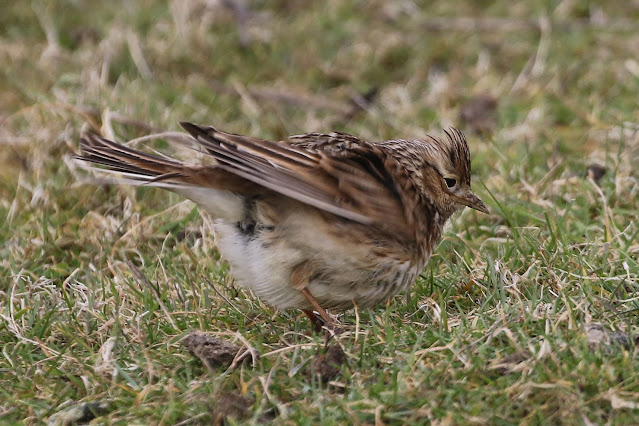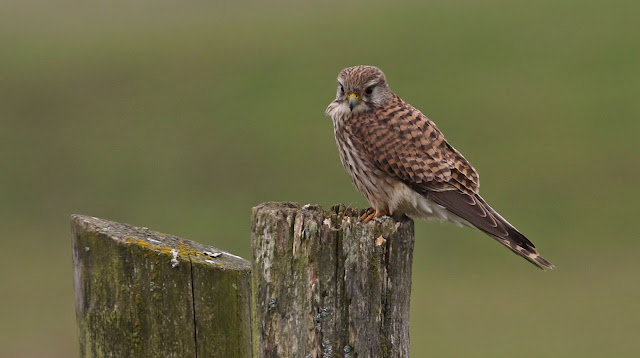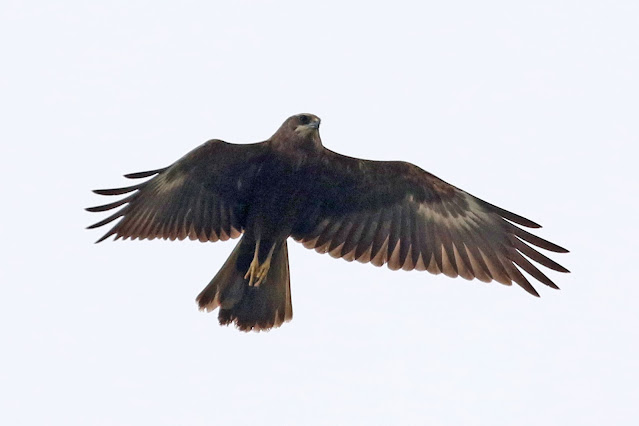Friday evening was cold, but with a very clear sky and the conjunction of Venus and Jupiter was very clear. The brightness of Venus (top of the photograph) made it very difficult to get a sharp image, but it was possible to make it out as a slight crescent. What was quite spectacular though was the fact that four of Jupiter's moons, Io, Europa, Ganymede and Callisto, all known as the Galilean
satellites, were clearly visible next to Jupiter (the bottom image).
They were first seen by Galileo Galilei in
December 1609 or January 1610 and recognized by him as satellites of Jupiter in
March 1610.
The moons are among the largest objects in
the Solar System with the exception of the Sun and the
eight planets, with radii greater than any of the dwarf
planets. Ganymede is the largest moon in the Solar System and is even bigger
than the planet Mercury.
Galileo originally called the moons the Cosmica
Sidera ("Cosimo's stars") but the names that eventually
prevailed were chosen by Simon Marius. Marius discovered the moons
independently at nearly the same time as Galileo, 8 January 1610, and gave them
their present names, derived from the lovers of Zeus.
Astronomy lesson over with, now to the main event. For the first time this year I was venturing outside of Hampshire, a visit to Kent to see daughter and granddaughter, allowed me an opportunity to visit Elmley. I have come to enjoy this reserve over the last year, but find it frustrating that on every visit it does rain. Nothing had changed today, and as I navigated the roadworks on the A249 it was drizzling quite hard.
One of my favourite parts of the reserve is the drive along the entrance track. It is possible to stop and observe and the birds will come quite close to the car which acts as a hide. The surrounding marsh was quite flooded, which was surprising considering the recent dry February we had experienced. Black-tailed Godwits were feeding in the pools and in the mud on the surroundings.
As I watched the godwits I noticed a slightly smaller wader with a shorter bill, a Ruff and from the size probably a male.
Here a comparison with the Black-tailed Godwit.
The Ruff is a large sandpiper; a typical wader, it feeds in
shallow water around lakes and wetland areas near the coast. Just a handful of
pairs breed in the UK, but some birds are present all year-round.
Most Ruff you will see are fairly plain-looking waders, with
a longish neck and small head. Non-breeding birds are pale fawn-brown all over,
with a paler belly. Breeding males, however, have a ruff of brightly coloured
feathers around the neck, head tufts and a bare, orange face. Ruff have a
short, slightly down-curved bill and orangey-yellow legs.
You could constantly here the "chirrup" calls of the Black-tailed Godwits and every so often a scuffle would break out as one bird was not happy if another ventured too close to where it was feeding.
It turned out that there were two Ruff, this individual having a white patch at the base of the bill.
Elmley is known for certain birds, more of which later, one of these is the Skylark, the wide open grasslands ideal habitat for this bird that was once a quintessential feature of our farmland and grasslands
habitats, however today it is declining rapidly with habitat loss. Fortunately Elmley is a stronghold and birds could be seen amongst the grass by the side of the track.
Male skylarks can be spotted rising almost vertically from
farmland, grassland, saltmarshes and moorland. They hover effortlessly, singing
from a great height, before parachuting back down to earth. These long and
complicated song-flights can last for up to an hour and the birds can reach
300m before descending.
They'll also sing from perches, such as fence posts or large
rocks. Despite their aerial activities, skylarks nest on the ground, laying
three to four eggs. Chicks become independent after only two weeks and parents
can have up to four broods in a breeding season.
Another wader commonly found around the marshes is the Redshank.
And it is no coincidence that the Lapwing features on the Elmley branding, they were every where and being able to get close to them from the car allows the opportunity to appreciate the different colours visible in the plumage.
I finally reached the main car park and was greeted by a very close male Marsh Harrier that drifted up from the Bricklands area.
Marsh Harriers are slightly larger than buzzards with
females being slightly larger than males. The largest of the
harriers, the marsh harrier creates a distinctive V-shape in the air by holding
its wings up.
This magnificent bird of prey is the largest of the harriers
and can be found throughout the year on the north Kent marshes. Once very
rare (in 1971, after years of persecution and habitat loss, only one nesting
female remained in the whole country), it has recently spread from its
stronghold in East Anglia to other parts of the country where reedbed habitat
is found. The UK breeding population is now approximately 400 pairs.
They breed in reedbeds and farmland and many now remain in
the UK over winter, here on the Isle of Sheppey roost numbers are well in excess of one
hundred
Females are dark brown with a cream coloured crown and pale
patches on the fore-wing and throat, while the males like this bird have dark wing tips and grey tail,
the breast and head appear yellowish with a brown belly, the upper-wing is a
combination of black, grey and brown. Juveniles are dark brown with a golden
crown and throat and a pale leading edge to the wing.
During the breeding season, males perform amazing courtship
displays, wheeling at great heights then diving towards the ground while
performing a series of tumbles; sometimes the female will join him and they
will lock talons mid-air. I witnessed some of the sky dancing today
After checking the scrub behind the car park for owls (all I could find were Woodpigeon!) I decided to take the path down hill towards the Bricklands area. I have now tried three times to see the Little Owls that reside at the ruins of the old school house.
In the field alongside the path there were two pairs of Stonechat and out in the field beyond were several male pheasants. As I approached the school house I noticed the Little Owl at the top of the remaining apex, but as I went for the camera it disappeared into the gap between the two walls. I waited to see if it would appear, and watched as two Jackdaw inspected the area in the hope it would flush the owl out. I then decided to walk down the hill to the reed bed at the bottom of the track and hoped the owl would come out when I returned.
A large flock of Stock Dove flew up from the field and then headed across the path in front of me.
More Marsh Harriers drifted across and in the reeds I could hear a Cetti's Warbler and there were also several Reed Bunting feeding on the tops of the reeds. Scanning across the marsh there were two Buzzards on posts and a group of Greylag Geese. The sun was trying to come out which made a welcome change from the drizzle and I also hoped it might tempt the Little Owl back out.
As I headed back towards the ruined building I could see the Little Owl back at the top of the apex. This time I used the cover of the building ruins and the surrounding trees to creep into a position to get a clear view.
It was perfectly aware I was there and was squinting at me.
Then as I edged a little closer it adopted a more aggressive posture, staring at me with those piercing yellow eyes.
A widespread and common species throughout Europe, eastwards
through the Middle East to Central Asia, and as far south as North Africa,
Little Owls were introduced into England in the 1800s by landowners who thought
that the species would be a useful addition to our native bird list.. From
there they quickly spread and by the 1920s could be found in Scotland and
Wales. Following that introduction in
the late 1800s, and the successful spread the species has experienced a decline in both range and
population. They are absent from Ireland, and have disappeared from almost all
of Scotland. Between 1995 and 2010 Little Owls declined by an estimated 40%,
particularly in the western part of their range. They are now considered scarce
in Wales and the western counties of Cheshire, Devon and Cornwall.

Little Owls are a cavity-nesting species, with nests
recorded in rock crags, rabbit holes and haystacks as well as in buildings and tree
holes. In the UK tree holes are by far the commonest natural site type. Little
Owls are faithful to their nest sites and will return year after year, provided
both of the pair survive.
Little Owls are most active at dawn and dusk, and after dark
when most hunting occurs. However, they can frequently be seen during the
middle of the day, basking in the sun on an exposed perch such as a telegraph
pole, dead tree or isolated building.
Rather than hunting on the wing, Little Owls usually hunt
from a perch, typically a fence post. When prey is spotted they sometimes ‘bob
up and down’ a few times before a typically short, low, undulating flight to
the ground where they sometimes pursue prey on foot. Whilst perched on a post
they blend into farmland environments extremely well and are easily overlooked.
Satisfied that at last I had managed to catch up with the Little Owl, I decided to leave it and make my way back to the car park, the brief interlude of sunshine had gone and the annoying drizzle was back. Looking across the field the pheasants that had been present earlier had been replaced by three Brown Hare.
The drizzle became much harder and at one point I considered I needed to find some substantial cover, the screen over looking the Swale hardly any shelter at all. The rain seems to come across the marsh from the north west and you know its on the way when you can't see the highland of the island. Fortunately it didn't last too long and once again the sun came out and we had a moment of blue sky.
The lake in the foreground had a good number of Pochard and Tufted Duck on it, on the shore were also Wigeon. I walked down the bank to get a closer look and heard the calls of Bearded Tit in the reeds. They were not easy to see and I was only able to get a few shots as this male appeared and disappeared in the reed stem, but it does convey the way these birds move around the reeds.
The marshes are covered with grazing wildfowl, there are huge numbers of Wigeon scattered across a large expanse. Every so often something will spook them, maybe a Marsh Harrier or other bird of prey and they will take to the air in an attempt to avoid the threat.


Once again the clouds were returning, out over the Swale a large flock of Golden Plover.
Looking to the east of the marshes I picked up a large flock of Starlings and they were being attacked by what looked like a Peregrine, the starling bunched together and went through the murmuration patterns in an effort to evade the attack.
The dark skies brought the drizzle back once again and I decided to walk back to the car park, rather than eat lunch in the car park I decided to head back down the entrance track and to use the car as a hide once more. I could find a suitable spot and eat lunch while watching.
As I left the car park I disturbed a female Kestrel from the side of the track and fortunately she flew to one of the old fence posts.
Secretly I wished she had been a Merlin!
I foud a suitable spot along the entrance track and pulled over and settled down. Around me the Lapwings were displaying their calls sound tracking the spectacular aerobatics.
In one of the pools close by a Redshank was scouring the margins.
One of the Ruff from earlier then appeared. Unlike the Redshank it preferred the grassy areas, pecking at the plants stems for insects and alike.
While all this was going on Marsh Harriers would criss cross the track putting up the duck and waders as they went, it was very unusual if you didn't find one as you scanned the marsh. This large female put up the feeding Wigeon.
This female passing overhead.
There were plenty of Coot in the pools and out on the marsh. The chasing individual here had swum across a pool, its target getting out of the water but the aggressor then chasing it across the field. Territory is defended with some really savage attacks.
Yet another Marsh Harrier cruising across the marsh.
This Lapwing had just finished bathing in the pool and was conducting an extensive preen to sort the feathers out. It was another chance to appreciate the petrol like colours in the plumage and the rusty colour of the vent and rump that is not always seen.
A big surprise was the appearance of a large flock of Black-tailed Godwits that came up from the long tussocky grass. They were flushed by yet another Marsh Harrier and spent some time wheeling around the marsh.
As I headed towards the exit I had one last encounter with a Marsh Harrier, fittingly, as they seemed to be everywhere today.
As I leftthe reserve I reflected on the day, whilst there had been rain it was not something theat prevented some great birding. Aside from not finding the the short-eared and Long-eared Owls I just about saw everything else. It is a wonderful place in Winter and I will be coming back as often as i can.












































































No comments:
Post a Comment